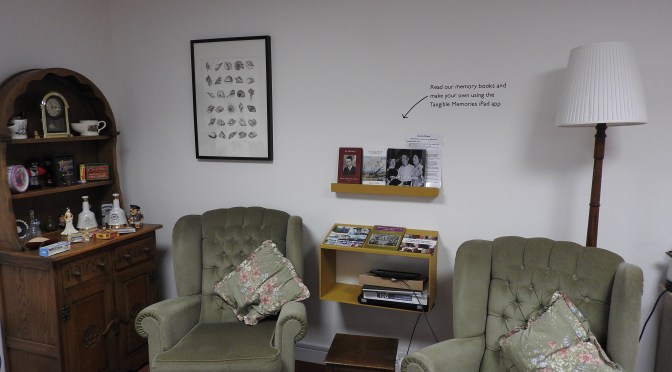Tangible Memories: Parlours of Wonder
‘Care-ful’ co-tinkering for elder care
Helen Manchester

As we face the discourses of impending doom around the ‘crisis of care’ in the UK and throughout the world there is a need to consider responses to demographic change and to explore solutions. Technological solutions are often hailed as a response to global and local problems of caring for older people (Peine et al, 2015; Neven, 2011). However, current design of new technologies for those in later life tend to follow old biomedical models where ageing is seen as a ‘problem’ and technology as a possible solution for ‘abnormal’ bodies and increased dependency (Vines et al, 2015; Blaschke et al, 2009). The Tangible Memories project adopts an alternative approach that recognises technologies as increasingly implicated in what it means to be human across the lifecourse and we call for a more critical and speculative approach to understanding and designing technologies for those in later life.
Tackling the crisis in social care through co-designing creative spaces, approaches and technologies alongside staff and residents in care homes the Tangible Memories: Parlours of Wonder project emerged from a very successful Connected Communities/ Digital Transformations project selected by the AHRC to be featured as one of their tenth anniversary films. During the TMP we worked with 3 care homes, Alive! (a charity dedicated to improving the quality of life for older people in care by enabling their participation in meaningful activity), computer scientists, artist Heidi Hinder and artists Stand + Stare to co-design a variety of methods to enable storytelling and enhance community within care settings. The project team planned and delivered staff training and had in depth conversations over 21 months with care staff, Alive! and artists concerning the development of the creative technologies and object orientated activities. We found that harnessing the power of innovative technologies and evocative objects in care settings impacted directly on relationships of care, on intra-generational relationships between residents themselves and on intergenerational relationships between residents and their families and friends. We believe that these creative technologies also have huge potential to enhance opportunities for older people living in care homes to connect and build community with those outside care homes and therefore to feel less socially isolated. We know that this will require a change of culture in many care settings and that working closely with care staff to co-design new spaces of encounter in these settings is vital.
Community engagement is increasingly recognised by the care sector and social care commissioners as vital in tackling issues of social isolation in our older populations living in care. Together we are co-designing engaging community spaces (Parlours) where older people can interact with evocative objects and our creative technologies to record and share their stories. This will involve imagining and creating a new space of discovery, connection, meaning making and mystery, rather like the ‘cabinets of curiosity’ or ‘wonder rooms’ of old. Unlike cabinets of curiosity, our ‘Parlours of Wonder’ will not be designed and curated by us as arts and humanities researchers, artists and computer scientists. Our vision is that these spaces will be co-curated by and for residents, care staff, families and community members. Parlours of Wonder are spaces where community engagement happens, where local school children, community groups and isolated older people are encouraged to enjoy a cup of tea and a chat or a more formal encounter, sparking questions, connections, new interests or opportunities for contemplation.
Our approach to co-design throughout the Tangible Memories project has involved a move away from understanding ‘innovation’ as the design of ‘novel’ products for market and towards a focus on innovation as crossing boundaries in order to ask questions of existing practices and begin to explore and design new ones (Bjorgvinsson, Ehn and Hilgreen, 2012). This co-creation is inclusive of different publics such that diverse perspectives on care can be raised (Storni, 2015) and places the maintenance of care (involving our bodies, ourselves, and our environment) at the centre of the process as well as central to the enquiry. Our processes therefore seek to unsettle notions of care through, for instance, questioning the traditional ‘passivity’ of those receiving care and allowing the invisibility of certain care and technological practices to be illuminated, but also through placing our own care-ful relations at the centre of the enquiry. Care-ful co-tinkering looks to enable new actors and tools to align across boundaries in trying out a more democratic and holistic future making approach to the design of technologies for care. The contention here is that speculative, experimental and open ended design projects are necessary in order to make ‘good’ care practices, that are embedded in the material world, more viable and present as everyday realities that touch all of our lives, are reflected in the everyday technologies we live alongside, and may therefore dynamically affect our futures.
We call for a more nuanced, critical and speculative approach to understanding and designing technologies for those in later life in order to build creative technologies that make a real difference to relations of care. A new methodology for the co-design of technologies of care might involves crossing boundaries through: care-ful collaboration and mutual learning in cross sectoral partnership; making visible existing and often invisible sociomaterial relations in institutions of care, accounting for embodied, technological and material relations and co-tinkering with practices of care, using design artefacts and processes.